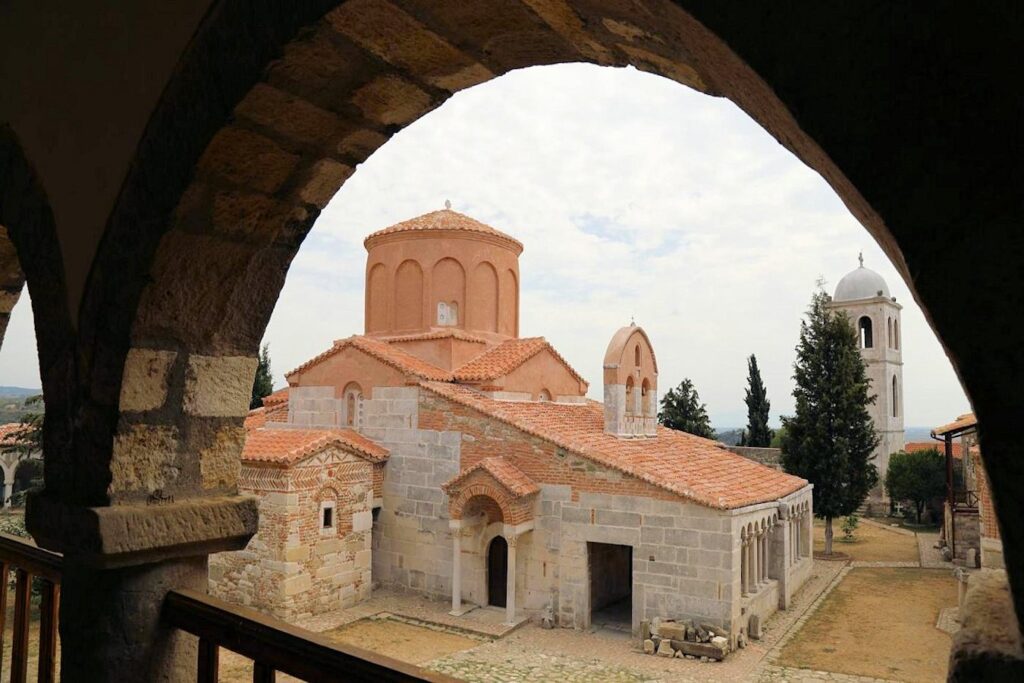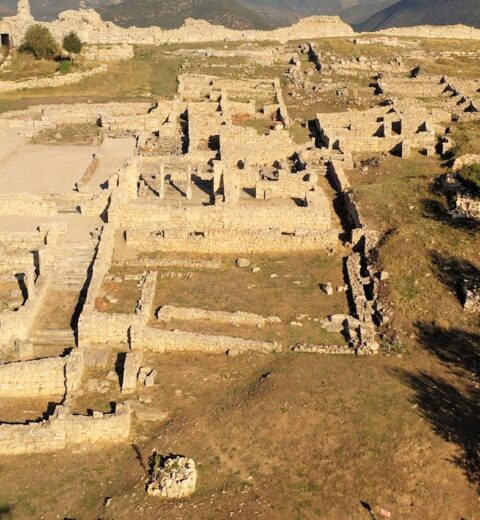Apollonia is an ancient city in Illyria. Located on a hill near the sea and close to what was then the course of the Vjosa River, its ruins are located 12 kilometers from the city of Fier, near the village of Pojan. Apollonia was founded in 588 BC, in a locality occupied by Illyrian tribes. The city flourished during the Roman period and was home to a renowned school of philosophy. The decline, however, began in the III AD. when – among other things – an earthquake devastated its port. Cicero, the famous Roman orator, was fascinated by the beauty of the city defining it in his Philippics “magna urbs et gravis”, or large and important city. Archaeological excavations have shown that the city reached its peak from the 4th century BC. to the 3rd AD; the sources paint a flourishing culture and a very active port during the city’s heyday, which also had its own mint for the production of coins, found up to the foot of the Danube.

Apollonia had a 4km long wall which surrounded an area of 137 hectares. It has been estimated that as many as 70,000 people lived in the city during the peak of civilization. Among the most interesting monuments are the city council building, the library, the triumphal arch and the temple of Artemis. Also noteworthy is the Odeon, which dates back to the 2nd century BC. and once housed around 10,000 spectators, and the two-story covered walkway, 77 meters long. An earthquake in the 3rd century AD it altered the course of the Voiussa river and caused serious damage to infrastructure.
The city’s population dwindled until it was almost uninhabited. It was rediscovered in the 1700s and archaeological excavations continued intermittently throughout the 20th century.
The decline of the city would seem to have been caused by the rise of the city of Vlora. It was rediscovered by European classicists in the 17th century although it was only in 1916-1918 with the Austrian occupation that archaeologists began to investigate the site. Their work was continued by a French team in 1924-1938. Parts of the site were damaged in World War II.

After the war, an Albanian team undertook further work from 1948 onwards, although much of the site remains unknown to this day. Some of the team’s archaeological discoveries are on display inside the monastery, known as the Museum of Apollonia, and in the capital Tirana. Unfortunately, during the anarchy that followed the collapse of the communist regime in 1990, the archaeological collection was looted and the museum was temporarily closed. The ruins were often excavated by looters for the relics to be sold to collectors abroad.
A new museum was inaugurated in December 2011, under the direction of Marin Haxhimihali. It replaced an older museum that dates back to 1985 and was funded by UNESCO. Today the site is easily accessible from the nearby town of Fier and offers both unique views of the Adriatic coast and a large collection of historical and archaeological objects of interest.
Excavations and monuments at Apollonia
The first attempts to conduct excavations were made during the First World War, by Austrian archaeologists who unearthed and explored mainly the walls surrounding the city.
Systematic excavations began in 1824 by a French archaeological mission headed by Leon Rey, which brought to light a complex of monuments in the center of the city.
Many excavations have been done by Albanian archaeologists over the past 40 years. Many objects found are exhibited in the museum which was once the monastery of Santa Maria.
The monument of Agonothetes
This monument decorated the city center. The structure had the shape of a semicircle and served as a meeting place for the city council – the Bule. The front of the structure has been decorated in a special way: there are 6 crowned pillars in the Corinthian style. An inscription dating back to the middle of the 2nd century AD says that the building was built by high-ranking officials of the city. On the day of the inauguration, a show was staged in the city with the participation of 25 pairs of gladiators. On the western side, tourists can see the ruins of the small temple of Artemis (Diana). On the eastern side there is a road which passes under a triumphal arch. On the opposite side of the Agonothetes monument, there is a colonnade decorated with marble statues
The library and the Odeon
The library stands behind the colonnade of the monument. Opposite, however, stands an Odeon or ‘small theatre’ which could hold 200 spectators. The building had a stage and an orchestra. There they performed musical performances and held oratorical and philosophical discussions.
The house with mosaics
A few meters away a rich Apolonian residence from the 3rd century AD has been excavated: the mosaics are of all types. There are mosaics where the main decorative motifs are simple geometric figures, others have ornamental mythological figures such as seahorses, accompanied by Nereids and Erotes. One of the mosaics depicts a scene in which Archiles holds the wounded Penthesilea, the beautiful queen of the Amazons, in his arms.
Fountain
It represents a complex structure in itself; it had a wall that collected all the waters that came from the earth and four other aqueducts.
The Museum of Apollonia
The Apollonia museum has 7 pavilions, a gallery and two porches. Here are exhibited various objects that bear witness to the history of the city of Apollonia.




